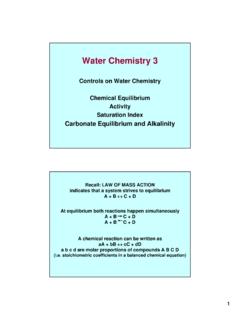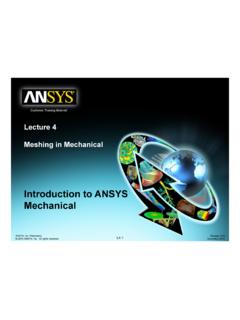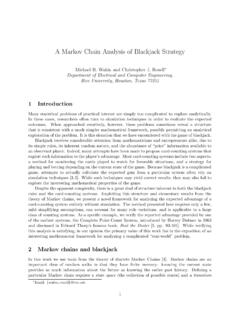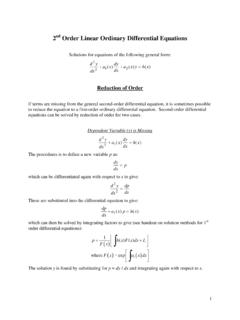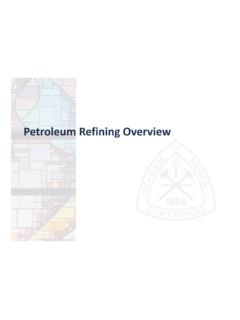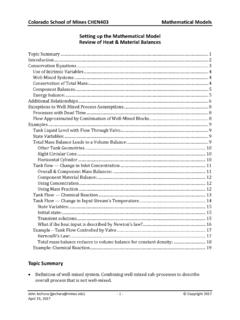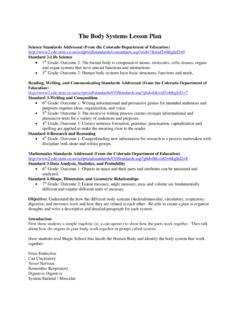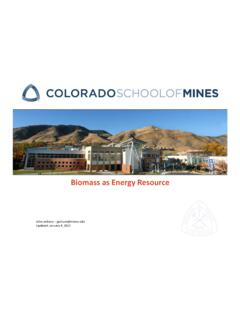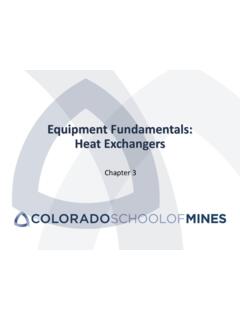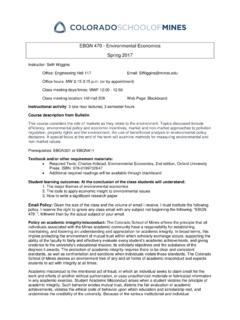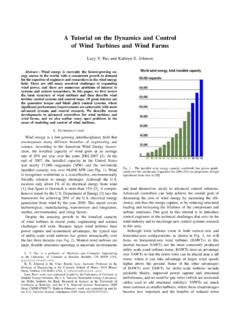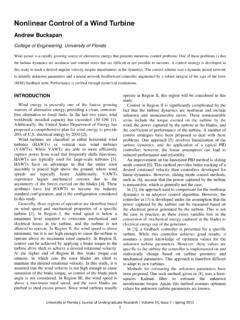Transcription of A Tutorial on the Dynamics and Control A Tutorial on the ...
1 Partners in the Colorado Renewable Energy Collaboratory s Center for Research and Education in WindA Tutorial on the Dynamics and Control of wind Turbines and wind FarmsLucy PaoKatie JohnsonJune 2009 American Control ConferenceSt. Louis, MO9:20-10:20 A Tutorial on the Dynamics and Control wind Turbines and wind Farms,Lucy Pao and Katie Johnson10:20-10:40 wind turbine Modeling Overview for Control Engineers,Pat Moriarty and Sandy Butterfield10:40-11:00 Control of wind Turbines: Past, Present, and Future,Jason Laks, Lucy Pao, and Alan Wright11:00-11:20 wind Farm Control : Addressing the Aerodynamic Interaction Among wind Turbines, Katie Johnson and Naveen ThomasA Tutorial on the Dynamics and Control of wind Turbines and wind FarmsPartners in the Colorado Renewable Energy Collaboratory s Center for Research and Education in WindA Tutorial on the Dynamics and Control of wind Turbines and wind FarmsLucy PaoKatie JohnsonJune 2009 American Control ConferenceSt.
2 Louis, MOPao & JohnsonAmerican Control Conference, June 2009 Partners in the Colorado Renewable Energy Collaboratory s Center for Research and Education in WindWind Energy Fastest growing energy source in the world Current global installed capacity exceeds 100,000 MW, with a projected growth of more than 20% per year for the next five years wind farms today produce electrical power at a Cost-of-Energy of approximately $ , comparable to that of coal and natural gas based power plantsIntroduction2[data from ]Pao & JohnsonAmerican Control Conference, June 2009 Partners in the Colorado Renewable Energy Collaboratory s Center for Research and Education in WindIncreasing turbine Size Typical size of utility-scale wind turbines has grown dramatically Large flexible structures operating in uncertain environments [video] Advanced controllers can help increase energy capture efficiency and reduce structural loading [diagrams and schematic from , , and ]Decrease the cost of wind energy3 IntroductionPao & JohnsonAmerican Control Conference, June 2009 Partners in the Colorado Renewable Energy Collaboratory s Center for Research and Education in WindOutline Motivation and wind turbine Basics wind turbine Control Loops Issues in turbine Control Advanced turbine Control wind Farms Offshore wind Conclusions4 OutlinePao & JohnsonAmerican Control Conference, June 2009 Partners in the Colorado Renewable Energy Collaboratory s Center for Research and Education in WindVertical vs.
3 Horizontal Axis wind Turbines Vertical-axis wind turbines (VAWTs) more common among smaller turbines HAWTs are the most commonly produced utility-scale wind turbines Advantages of horizontal-axis wind turbines (HAWTs) Improved power capture capabilities Pitchable blades Improved structural performanceIntroduction5[photo from ][photo courtesy of L. J. Fingersh, NREL]Pao & JohnsonAmerican Control Conference, June 2009 Partners in the Colorado Renewable Energy Collaboratory s Center for Research and Education in WindVertical vs. Horizontal Axis wind Turbines Vertical-axis wind turbines (VAWTs) more common among smaller turbines HAWTs are the most commonly produced utility-scale wind turbines Advantages of horizontal-axis wind turbines (HAWTs) Improved power capture capabilities Pitchable blades Improved structural performanceIntroduction5 Horizontal Axis wind TurbinerotorNREL s Control Advanced Research turbine (CART2)nacelletowerPao & JohnsonAmerican Control Conference, June 2009 Partners in the Colorado Renewable Energy Collaboratory s Center for Research and Education in WindWind turbine Components wind encounters rotor, causing it to spin Low-speed shaft transfers energy to the gear box Steps up speed Spins high-speed shaft High-speed shaft causes generator to spin, producing electricity Yaw system turns nacelle so that rotor faces into the windIntroduction6[figure courtesy of US Dept.]
4 Of Energy]Upwind HAWTPao & JohnsonAmerican Control Conference, June 2009 Partners in the Colorado Renewable Energy Collaboratory s Center for Research and Education in WindWind turbine Design Considerations Upwind vs. downwind Tower shadow Variable or fixed pitch Initial cost Ability to Control loads and change aerodynamic torque Variable or fixed speed Aerodynamic efficiency Electrical power processing Number of bladesIntroduction7[figure courtesy of US Dept. of Energy]Upwind HAWTPao & JohnsonAmerican Control Conference, June 2009 Partners in the Colorado Renewable Energy Collaboratory s Center for Research and Education in WindOperating Regions Region 1: Low wind speed (below 6 m/s) wind turbines not run, because power available in wind is low compared to losses in turbine system Region 2: Medium wind speeds (6 m/s to m/s) Variable-speed turbine captures more power Fixed-speed turbine optimized for one wind speed (10 m/s) Max difference in example curves is 150 kW.
5 For typical wind speed distributions, in this example, variable-speed turbine captures more energy than constant-speed turbine Introduction8 Region 3: High wind speeds (above m/s) Power is limited to avoid exceeding safe electrical and mechanical load limitsExample Power Curves for MW wind TurbineRegion 1 WindPowerVariableSpeedTurbinePowerFixed Speed turbine PowerPao & JohnsonAmerican Control Conference, June 2009 Partners in the Colorado Renewable Energy Collaboratory s Center for Research and Education in WindOutline Motivation and wind turbine Basics wind turbine Control Loops wind Inflow Sensors Actuators Torque Control Pitch Control Issues in turbine Control Advanced turbine Control wind Farms Offshore wind Conclusions9 OutlinePao & JohnsonAmerican Control Conference, June 2009 Partners in the Colorado Renewable Energy Collaboratory s Center for Research and Education in WindWind turbine Control LoopsTorque ControllerPitch Controller WindDesired Rotor Speed dSpeed SensorPitch MotorPower ConverterRotor SpeedPitch AngleLoad Torque e turbine axisinstantaneous wind field10 Walk Around the LoopsPao & JohnsonAmerican Control Conference.
6 June 2009 Partners in the Colorado Renewable Energy Collaboratory s Center for Research and Education in WindWind Inflow Differential heating of atmosphere is driving mechanism for earth s winds Numerous phenomena affect wind inflow across a wind turbine s rotor plane Sea breezes Frontal passages Mountain and valley flows Nocturnal low-level jet Rotor plane of MW utility-scale turbines span from 60m to 180m above the ground Virtually impossible to obtain a good measurement of the wind speed encountering the entire span of blades11 Walk Around the Loops[Figure courtesy of R. Banta, Y. Pichugina, N. Kelley, B. Jonkman, and W. Brewer]Hourly profiles of mean wind speed after sunset on 15 Sept 2003 Pao & JohnsonAmerican Control Conference, June 2009 Partners in the Colorado Renewable Energy Collaboratory s Center for Research and Education in WindCharacterizing the wind Average wind speed Spatial Temporal Frequency distribution of wind speeds Spatial Temporal Prevailing wind direction Frequency of other wind directions Capacity FactorCF =actual energy output over time periodenergy output if turbine operated at max output over same time period12 Walk Around the Loops kkkcwcwkwfexp)(1c: scale parameter k.
7 Shape parameterwind speed w(m/s)probability densityk = = 2k = = 3 Example Weibull DistributionsPao & JohnsonAmerican Control Conference, June 2009 Partners in the Colorado Renewable Energy Collaboratory s Center for Research and Education in WindWind turbine Control LoopsTorque ControllerPitch Controller WindDesired Rotor Speed dSpeed SensorPitch MotorPower ConverterRotor SpeedPitch AngleLoad Torque e turbine axisinstantaneous wind field13 Walk Around the LoopsPao & JohnsonAmerican Control Conference, June 2009 Partners in the Colorado Renewable Energy Collaboratory s Center for Research and Education in WindSensors Rotor speed measured on either high-speed (generator) or low-speed (rotor) shafts Gear box ratio known Anemometers used for supervisory Control purposes Usually located on nacelle behind rotor plane Power measurement devicespoor measurement of wind [figure courtesy of US Dept.]
8 Of Energy]Upwind HAWT14 Walk Around the LoopsPao & JohnsonAmerican Control Conference, June 2009 Partners in the Colorado Renewable Energy Collaboratory s Center for Research and Education in WindSensors Rotor speed measured on either high-speed (generator) or low-speed (rotor) shafts Gear box ratio known Anemometers used for supervisory Control purposes Usually located on nacelle behind rotor plane Power measurement devicespoor measurement of windSeveral types of sonic and propeller anemometers on a meteorological tower at NREL s NWTC[Photo courtesy of L. J. Fingersh, NREL]15 Walk Around the LoopsPao & JohnsonAmerican Control Conference, June 2009 Partners in the Colorado Renewable Energy Collaboratory s Center for Research and Education in WindAdditional Sensors Strain gauges Tower Blades Accelerometers Position encoders Drive shaft Blade pitch actuation systems Torque transducers 16 Walk Around the Loops[figure courtesy of US Dept.
9 Of Energy]Upwind HAWTPao & JohnsonAmerican Control Conference, June 2009 Partners in the Colorado Renewable Energy Collaboratory s Center for Research and Education in WindWind turbine Control LoopsTorque ControllerPitch Controller WindDesired Rotor Speed dSpeed SensorPitch MotorPower ConverterRotor SpeedPitch AngleLoad Torque e turbine axisinstantaneous wind field17 Walk Around the LoopsPao & JohnsonAmerican Control Conference, June 2009 Partners in the Colorado Renewable Energy Collaboratory s Center for Research and Education in WindActuators Yaw motor Slow (usually < 1 deg/s) Generator Fast (time constant usually > 10x that of rotor speed) [figure courtesy of US Dept. of Energy]Upwind HAWT18 Walk Around the LoopsPao & JohnsonAmerican Control Conference, June 2009 Partners in the Colorado Renewable Energy Collaboratory s Center for Research and Education in WindActuators Yaw motor Slow (usually < 1 deg/s) Generator Fast (time constant usually > 10x that of rotor speed) [Photo courtesy of L.
10 J. Fingersh, NREL]Inside the Nacelle of the 3-Bladed Controls Advanced Research turbine (CART3) at NREL sNational wind Technology Center (NWTC)CART3 is a 600 kW wind turbine with a 40 m rotor diameter that is used at NREL sNWTC as an experimental test bed for advanced Around the LoopsPao & JohnsonAmerican Control Conference, June 2009 Partners in the Colorado Renewable Energy Collaboratory s Center for Research and Education in WindActuators Blade pitch motor Fast Up to 18 deg/s for 600 kW turbines Up to 8 deg/s for 5 MW turbines Collective vs. Individual Pitch[Photo courtesy of L. J. Fingersh, NREL]Three pitch motors on the CART3 Yaw motor Slow (usually < 1 deg/s) Generator Fast (time constant usually > 10x that of rotor speed) CART3 is equipped with independent blade pitch Around the LoopsPao & JohnsonAmerican Control Conference, June 2009 Partners in the Colorado Renewable Energy Collaboratory s Center for Research and Education in WindMore on Actuators Operational blade pitch angle data from CART2.
